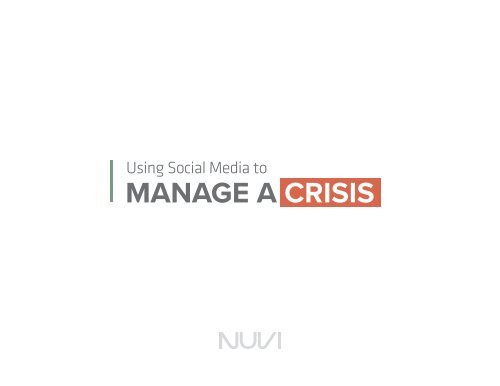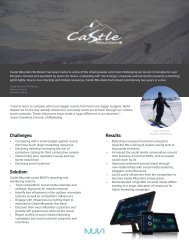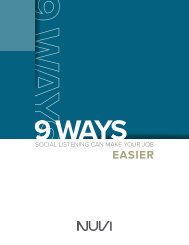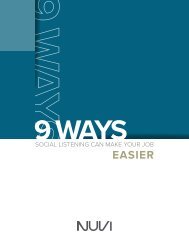Crisis Management Guide
Create successful ePaper yourself
Turn your PDF publications into a flip-book with our unique Google optimized e-Paper software.
Using Social Media to<br />
MANAGE A CRISIS
When thinking about all that goes into planning for crisis management, it’s easy to think<br />
of situations that involve police and firefighters, natural disasters, and other devastating<br />
events. While at the time it can seem like the sky is falling down around your organization,<br />
not all crises involve such drastic situations. Either way, the idea of trying to prepare for an<br />
unforeseen event can be rather daunting.<br />
There are two main<br />
reasons why a business<br />
may be unprepared to<br />
handle a crisis:<br />
1<br />
2<br />
First, many companies aren’t thinking about planning for a crisis. It<br />
is easy to watch the news and see a giant company facing an issue<br />
and think, “That will never happen to my company.”<br />
Those companies that have management procedures in place,<br />
aren’t looking in the right places.<br />
Regardless of how your organization defines a crisis –for some it could be a surge in cases<br />
of food poisoning due to spoiled ingredients; for others, it may be a well-intended ad missing<br />
the mark– the one thing they all have in common is social media. Social has replaced<br />
television and newspaper as the major source of day-to-day information. If there is an<br />
impending crisis that could damage your company’s reputation, you’ll likely find it on social<br />
first.<br />
We at NUVI have been helping clients leverage social insights to prepare for, and manage<br />
their way through many different crisis situations. Since we get so many questions regarding<br />
efficient crisis management, we realized that it must be a widespread concern.
That’s why we have come up with this <strong>Crisis</strong> <strong>Management</strong> Playbook to<br />
help organizations like yours prepare a plan to effectively manage crisis<br />
situations, minimize the effect, and take appropriate action in real time.<br />
In this playbook, we will<br />
walk you through the<br />
steps to managing a crisis<br />
through social media.<br />
Identify the <strong>Crisis</strong><br />
You can’t manage a crisis you don’t know about. The<br />
first step is to know what is happening. It’s natural to<br />
assume that if a crisis is happening around your brand<br />
that you would be the first to know about it. That’s not<br />
always the case. Things can happen quickly, and in a<br />
rush communication can break down, leaving decision<br />
makers unaware of the situation.<br />
Enter social insights.<br />
As mentioned earlier, news moves fast across the<br />
various social platforms. For example, if there is a<br />
problem with your product or service, you can almost<br />
guarantee people will be talking about it on Twitter. Remember Pepsi’s ad<br />
campaign featuring Kendall Jenner? In the blink of an eye people went to<br />
YouTube to post videos mocking the video and calling for Pepsi to take it down.<br />
Keeping a close watch and monitoring brand/ campaign specific keywords will<br />
help keep you in the know. But what about others within your organization that<br />
need to stay informed of a potential crisis?<br />
Setting up alerts to know when people are talking about your brand on social<br />
media is a quick way to know about things that are happening in real-time.<br />
Through NUVI’s latest product, Monitors Enterprise, you can set up alerts to<br />
know when sentiment around your online conversation shifts for the worse, if the<br />
overall conversation around your brand spikes, and even anytime your brand<br />
is mentioned in relation to certain key phrases. You can even have these alerts<br />
delivered via text or email to multiple people.
Understand the Conversation<br />
Without knowing where the conversation started, what people are talking about, and<br />
what that sentiment is, it’s much harder to respond to the conversation. Remember<br />
that whole thing with United? Their first response seemed out of touch and didn’t<br />
seem to be responding to the deeper issue at hand.<br />
Very few companies ever need to worry about losing $1.4 billion because of a<br />
single issue. But what we can take from United’s debacle is that the only thing worse<br />
than having a crisis in the first place is making it worse through mishandling. A poorly<br />
executed ad campaign, like the Dove example below, does enough damage on its<br />
own. But when coupled with a corporate response that obviously didn’t understand<br />
the damage done, or is more concerned with saving face than truly fixing the issue,<br />
well that is a formula for disaster.<br />
This disaster is preventable. Since you are actively monitoring the use of specific<br />
keywords across the various social platforms, blogs, and news sites, you’ve already<br />
identified a sudden spike of negative sentiment. Now, thanks to real-time data, you<br />
understand the conversation and can quickly put together an appropriate response.<br />
In the case of this Dove ad, their social media accounts were quick to acknowledge<br />
their mistake and apologize. They also made promises to be more sensitive in future<br />
ad campaigns. Dove understood the conversation around their ad and understood<br />
what their audience wanted. They were then able to use that information to issue an<br />
appropriate response.
Respond Appropriately and Quickly<br />
Finding the balance between responding both quickly and appropriately is hard to do. On one<br />
hand, there’s the urgency to address the issue as quickly as possible and get a message out.<br />
Simultaneously, a poorly planned response will only make matters worse. It’s vital to gather all<br />
of the information you can quickly so that you can respond appropriately and get ahead of the<br />
conversation. It’s important to know who you should be responding to as well.<br />
Both marketing and PR agencies<br />
are tasked with issuing responses<br />
when crisis ensues, so how do<br />
they walk that line and create<br />
a plan that is both timely and<br />
contextually appropriate?<br />
1<br />
2<br />
3<br />
Know and understand your audience. Hopefully this is research you do on a regular basis. You<br />
should know who might be upset by this issue and why.<br />
Understand the issue. Using a social listening solution will enable you to see the conversation<br />
as it is happening in real-time. This will make it possible to quickly see what is being said<br />
about your campaign or brand and plan the best course of action possible.<br />
Don’t wait to read about it in the newspaper. You should have your finger on the pulse of your<br />
industry and audience. If you are only finding out there is an issue after everyone else already<br />
knows…well, that’s not a great start.<br />
With the insights you’ve gained from social listening, you understand what<br />
people are saying, who is saying what, and more importantly, how far it is<br />
spreading. Now is the time to respond. You can post something to your<br />
Facebook, Twitter, and blog like Dove did. But don’t forget about responding to<br />
the affected individuals. Reach out, one-to-one, and respond to your audience.
<strong>Management</strong> and Analysis<br />
Once you have made an initial response, it’s important to keep track<br />
of the sentiment around that response, and then continue to be a<br />
part of the conversation. It isn’t enough to just issue a press release<br />
and then go back to your day-to-day activities, assuming all is fine.<br />
Depending on the size of the crisis, you could experience fallout for<br />
many days or even weeks.<br />
It becomes vital to your management efforts that you continually<br />
engage with your audience. A public forum like social media is a great<br />
way to accomplish this; but beware, it can be a double-edged sword.<br />
Here’s what I mean. Let’s say you are responding to someone who<br />
tweeted at your company that they are hurt or offended by something<br />
your company did or didn’t do. All of your followers and all of theirs can<br />
see this tweet. They will see your response. This can be great PR and<br />
will show everyone that your company is authentic and genuinely trying<br />
to fix the problem. But– what if you don’t respond at all? What message<br />
are you sending? What if your response is totally off the cuff and fails to<br />
really address the problem or worse, that it tries to shift blame and deny<br />
responsibility? Now you have a full-blown PR nightmare on your hands.<br />
An important part of your crisis management plan should be a long-term<br />
strategy for not only fixing the issue, but putting additional preventative<br />
measures in check to make sure it doesn’t happen again. As we<br />
mentioned before, alerts are a great way to keep your finger on the pulse<br />
of your industry. There may be things that come up that affect your whole<br />
industry, even if it wasn’t your fault.
Conclusion<br />
A timely, appropriate reaction is vital to minimizing the effect of a crisis. Social media<br />
can be merciless in the face of a crisis. News is shared in the blink of an eye and<br />
issues tend to snowball and escalate at break-neck speeds. Likewise, social be an<br />
incredibly effective tool to research issues and publicly engage with audiences. It<br />
helps keep you apprised of the conversations around your brand and stay ahead<br />
of a crisis. NUVI has the solutions to help you know when a crisis is happening,<br />
understand the conversation, know how to respond, and then continue to track<br />
the conversation. Real-time sentiment analysis and social listening can make all the<br />
difference in staying ahead of a problem.<br />
www.nuvi.com









